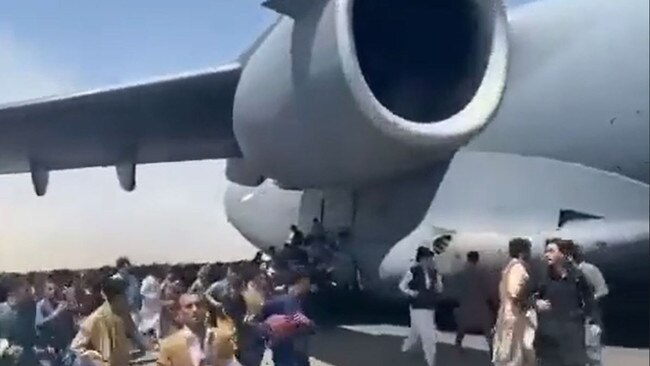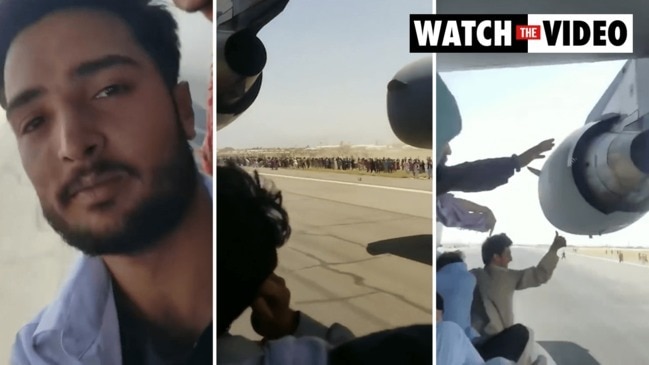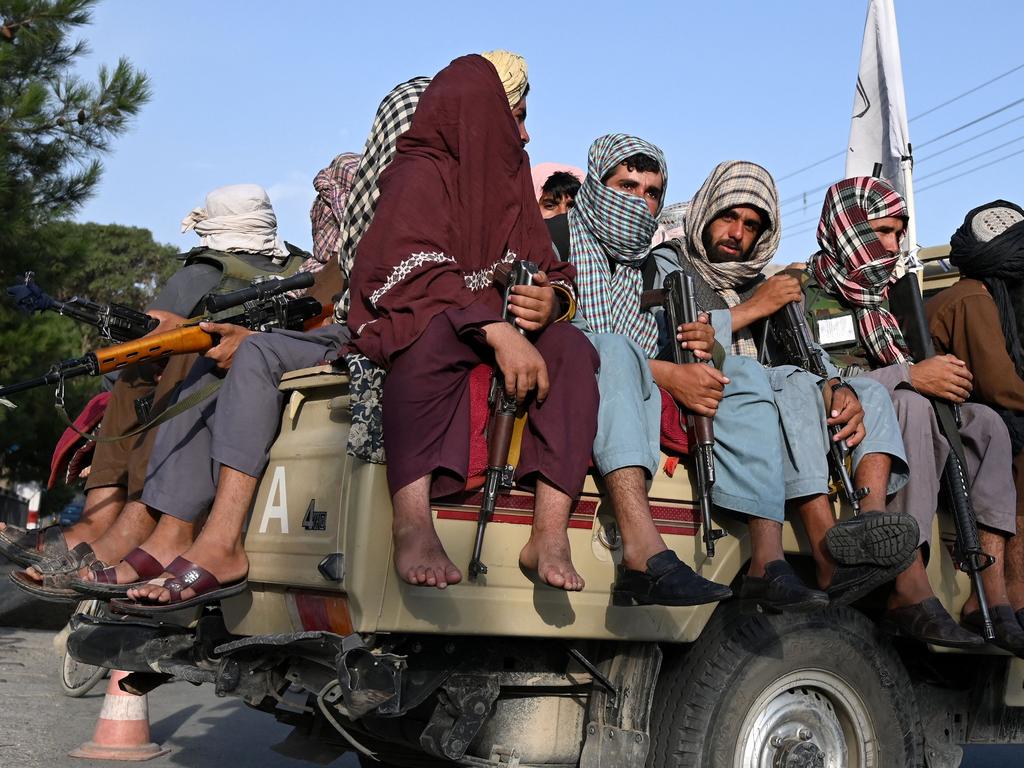Afghanistan’s falling man: The 17-year-old soccer star who plunged from a US military jet
Zaki Anwari saw no future as the Taliban streamed into Kabul. Viral images of his death horrified the world | WARNING: GRAPHIC

Hundreds of Afghans were swarming the runway of Hamid Karzai International Airport, attempting to climb onto a taxiing 140-ton U.S. army transport plane as two Apache helicopters buzzed low to try and disperse them. Powering through the scrum in a green tunic, 17-year-old Zaki Anwari made his way to the front and clambered onto the plane’s landing gear. As it accelerated past 120 miles per hour, he held tight.
Hours earlier, as the Taliban began its first morning in charge of Kabul, Mr. Anwari, a high school senior and attacking midfielder for the national youth soccer team, had phoned his brother to tell him that if he didn’t flee Afghanistan he would never play again.
“Do not go, go back, you are smart, don’t go,” his elder brother Zakir implored. “I have to try,” Mr. Anwari replied.

Millions of people saw footage of what happened next: a defining image from America’s chaotic exit from a 20-year war that had an unsettling resonance with the 9/11 attacks that ignited it. As the C-17 Globemaster III arched skywards over Kabul, Mr. Anwari fell.
Inside the cockpit, the crew had made a snap decision to take off to escape the surrounding crowd. Mr. Anwari, nicknamed “Shield” for his ability to keep the ball, couldn’t hold on.
“They are falling over there,” a bystander said in one video shot from the runway, as a crowd ran towards the silhouettes falling to the ground. “Oh my God, oh my God,” he said.
At least two other young men died that day, according to aid agencies, another falling from the plane around the same time as Mr. Anwari, a third crushed by the retracting landing gear. Several other young men gripping onto the C-17 would have shared their fate if they hadn’t leapt seconds before the wheels left the runway.
All of them were members of a new generation of Afghans who had never known rule by the Taliban and were terrified enough by what the militant group’s return to power would mean for them that they were willing to grab hold of an accelerating military jet if it meant a ticket out. Their story is a parable for the dashed hopes of a younger generation of Afghans born after the Taliban were pushed from power in 2001.


“It was not just the fall of Kabul. It was the fall of a whole new generation who believed and worked for progressive Afghanistan,” Shafiqa Khpalwak, a Kabul-based poet, wrote on Twitter. “Trusted the world. And hoped for a brighter future.”
The following reconstruction is based on interviews with Mr. Anwari’s friends, family, bystanders who witnessed the episode and reviews of video, military-aviation experts and photos shot at the scene.
In a statement, the U.S. Air Force said it was conducting an investigation to “better understand how events unfolded,” and “to prevent a situation like this from happening again.” Most of Afghanistan’s 38 million people were not born when the Taliban last ruled. At 17, Mr. Anwari and his teammates in Kabul had lived a childhood unimaginable for their parents.
Soccer, disdained by the Taliban, has become a symbol of Afghanistan’s reintegration into the world. Schoolchildren — boys and girls — in cities like Kabul, Kunduz and Kandahar declared loyalties to clubs oceans away like Barcelona, Manchester United and Chelsea. Mr. Anwari earned a spot on the national team, playing midfield in the same stadium where the black-turbaned Taliban had once performed public executions: beheading, stoning and shooting victims and hanging the amputated limbs of thieves from the goalposts.

As the Taliban returned, Mr. Anwari joined a new rush of elite athletes seeking to flee. At roadblocks manned by whip-wielding Taliban fighters, footballers trying to leave have been beaten in crowds. Others have reported menacing visits by Taliban members.
On Tuesday, the International Federation of Professional Footballers, a global athletes union, said it had helped successfully airlift a group of 77 women and girl players and their families to Australia.
Mr. Anwari was determined to make his own escape. Earlier this month, as the Taliban’s lightning offensive brought them closer to the capital, Mr. Anwari and his friends had been fearfully discussing what to do. “We should all leave,” one said, over a lunch of rice and beef. “If they come, I will leave this country,” Mr. Anwari declared.
He had been born two years after the US-led coalition ousted the Taliban and on the eve of Afghanistan’s new constitution and elections where long lines of Afghans turned out to vote. From Kabul, he was a citizen of the country’s most diverse and socially liberal city, and his life traced the arc of a segment of society slowly globalizing.

Mr. Anwari, the son of a retired businessman, attended the elite French high school, on a secluded bougainvillea-draped campus near the presidential palace. He captained the school team and by 2015 was playing for local clubs, wearing the number 10 jersey favored by some of the game’s most gifted playmakers: Diego Maradona, Pele and his idol, Lionel Messi. Modelling himself on the diminutive Argentine, he studied YouTube videos and practised late to try and replicate his dribbling and eye for the killer pass.
Mr. Anwari and his school friends had traded frightening stories about what the Taliban had done to their parents’ generation, but by 2017, the war was increasingly intruding into their world. That summer, a Taliban suicide bomber detonated at the intersection next to the school, forcing him to flee in terror with classmates.
The school was closed for a week, said one friend, Abdullah. “Zaki was very shaken up,” he said.
In 2018, Mr. Anwari appeared at school with a surprise in his bag: his new red jersey from the Afghanistan national youth team. “He bought us all burgers that day to celebrate,” Abdullah said.
He posted photos on Facebook wearing his Afghan jersey and looking confident and resolute. On another post, clad in a business suit, he wrote: “You’re the painter of your live [sic]. Don’t give the paint brush to anyone else!” But Mr. Anwari’s mood darkened as the Taliban advanced across Afghanistan in August. He confided to his brother Zakir that an insurgent victory would wreck his dreams on the soccer field and beyond. “He was young and had never seen the Taliban,” Zakir said. “He was afraid.” On the night the Taliban reached the gates of Kabul, Mr. Anwari called another youth team player, Frotan, and asked: “How will we still play football?” “All our dreams were crushed to dust,” Froton said.


On Monday morning, the day after the Taliban seized the capital, Mr. Anwari told his brother Zakir he was headed to clean the family car. At 10:57am., Mr. Anwari called Zakir, the rumble of engines and cheering crowd in the background.
“I’m at the airport,” Zaki said hurriedly.
“You don’t have a visa or a ticket. Come home,” Zakir snapped back. “I’m already close to the plane,” Zaki said. “This is a chance to trust in God.”
Not far away, the U.S. C-17 loaded with equipment had landed on the runway on the military side of Hamid Karzai International Airport. A day earlier, another of the gunmetal grey planes had evacuated 823 Afghans who climbed through the cargo ramp to squeeze into the plane’s cavernous interior.
Now, hundreds more civilians — Zaki Anwari among them — had breached the airport perimeter and were congregating on the runway, hoping to do the same. Before the C-17 crew could unload their cargo of military equipment, the plane was swarmed by Afghans desperate to jump aboard.
In the melee, the C-17 pilot made a judgement: The plane needed to get out of Kabul, immediately, without taking on passengers.
“Faced with a rapidly deteriorating security situation around the aircraft, [they] decided to depart the airfield as quickly as possible,” an Air Force spokesman said.

It was the best of a bad set of available options, said Cedric Leighton, a retired U.S. Air Force colonel and founder of a security consultancy: “You have to make a decision as a crew: Is the safety of my crew, plane, and cargo more important than the safety of those hanging onto my aircraft?” he said. “You don’t know who these folks are.”
The plane turned around and began to taxi along the runway, flanked by armored Humvees and two helicopters swooping low. But the crowds quickly reconstituted, cheering and whooping, as hundreds of men convulsed around the plane’s giant wings and four booming engines.
Zaki Anwari had pushed himself to the head of the small group of men athletic enough to haul themselves onto the landing gear under the right wing, as the plane began to accelerate. Around him, men were trying to grab onto different parts of the plane; One was even clutching onto the support structures holding the front wheel.
Mr. Anwari gripped the plane’s exterior, staring straight ahead, in videos captured by bystanders. His muscles tightened and his expression steeled, in total concentration. Around him, other men holding onto the plane began to wave excitedly at the cheering crowd, while others stared forward, visibly afraid.
As the C-17 gained speed, most of the group began to abandon the effort, running off across the runway. Others sprinting alongside whooped or punched the air as the engine roar intensified and the aircraft accelerated.
“Hey where are we going?” one man still clinging to the plane shouted. “The wind will hit us,” warned another, as some abandoned their perches to save themselves.
Mr. Anwari held fast.
A couple of hours later, his brother, Zakir, got a call. “Do you know Zaki Anwari?” a voice on the other end said.
WSJ







To join the conversation, please log in. Don't have an account? Register
Join the conversation, you are commenting as Logout